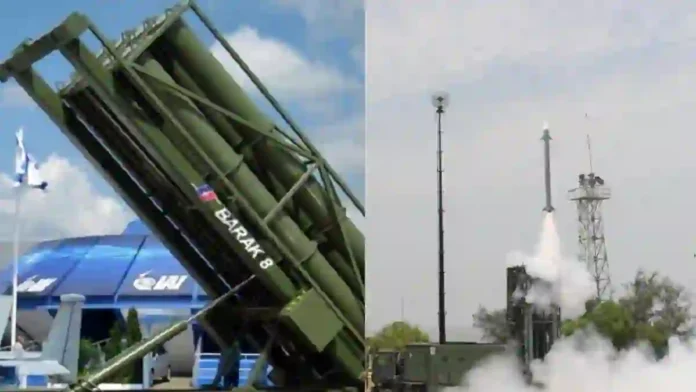The Barak-8 air defence system, a product of Indo-Israeli collaboration, has made its operational debut in the ongoing Iran-Israel conflict, marking a significant milestone in international defence cooperation and the effectiveness of modern air defence technology.
Development And Capabilities
Barak-8, also known as the Medium Range Surface to Air Missile (MRSAM), was jointly developed by India’s Defence Research and Development Organisation (DRDO) and Israel Aerospace Industries (IAI). The system is designed to counter a broad spectrum of aerial threats, including unmanned aerial vehicles (UAVs), cruise missiles, combat aircraft, and ballistic missiles. It features a range of up to 100 kilometres, vertical launch capability, active radar seekers, and 360-degree coverage, enabling it to engage multiple targets simultaneously, even under saturation attack conditions.
Read- India Confronts Twin Drone Threats From Pakistan And Bangladesh
India contributed significantly to the missile’s propulsion and subsystem development, while Israel provided advanced seeker technology and avionics expertise. The Barak-8 system is already operational with the Indian Navy and Air Force and is being inducted into the Indian Army, with contracts between the two nations valued in the billions of dollars.
Operational Debut In The Iran-Israel Conflict
During recent hostilities, the Israeli military deployed both land and naval variants of the Barak-8 system for the first time in combat. The Israeli Air Force used the Barak air defence system to intercept an Iranian drone that had breached Israeli airspace, marking its first operational use by the Air Force. The Israeli Navy, meanwhile, employed the naval variant—Barak Magen—aboard Sa’ar 6-class corvettes to intercept eight Iranian drones in a single night, showcasing the system’s advanced maritime defence capabilities.
The Barak Magen system, a naval adaptation of the Barak MX family, is integrated into Israel’s newest warships and is capable of defending against UAVs, cruise missiles, ballistic missiles, and enemy aircraft. The successful interception of Iranian drones by Barak Magen marked its first combat test and demonstrated its role in plugging critical gaps in Israel’s layered air defence network.
Read- Should India Be Worried About Pakistan’s Chinese J-35 Stealth Jets? A Strategic Analysis
Read- U.S. Enters Israel-Iran War; Bombs Key Iranian Nuclear Sites
Strategic Significance
The deployment of Barak-8 in the Iran-Israel conflict underscores the growing strategic value of India-Israel defence cooperation. The system’s ability to neutralize advanced aerial threats, including drone swarms and precision missile attacks, has drawn global attention and over $1.2 billion in international sales. Its combat success has reinforced the reputation of Indo-Israeli co-development as a model for joint defence innovation.
Indian Operational Experience
India has also demonstrated the Barak-8 system’s effectiveness in its own operational environment. In Operation Sindoor, the system intercepted a Pakistani Fatah-II missile over Sirsa, Haryana, believed to be targeting Delhi. The missile system has undergone rigorous testing on both land and sea, including integration on Indian Navy platforms such as INS Kolkata, INS Chennai, and the aircraft carrier Vikramaditya.
Technical Features
Range: 70–100 km
Speed: Up to Mach 2
Warhead: 60 kg proximity-fused
Guidance: Active radar seeker with MF-STAR AESA radar
Coverage: 360-degree, vertical launch
Multi-Target Engagement: Capable of intercepting several threats simultaneously
Summary
The Barak-8 air defence system’s operational debut in the Iran-Israel conflict, particularly its successful interception of Iranian drones targeting Israel, highlights its advanced capabilities and the strategic depth added by Indo-Israeli defence collaboration. Its proven performance in both Indian and Israeli service positions it as a key player in modern air defence, capable of countering evolving aerial threats in complex conflict environments.
Agencies




